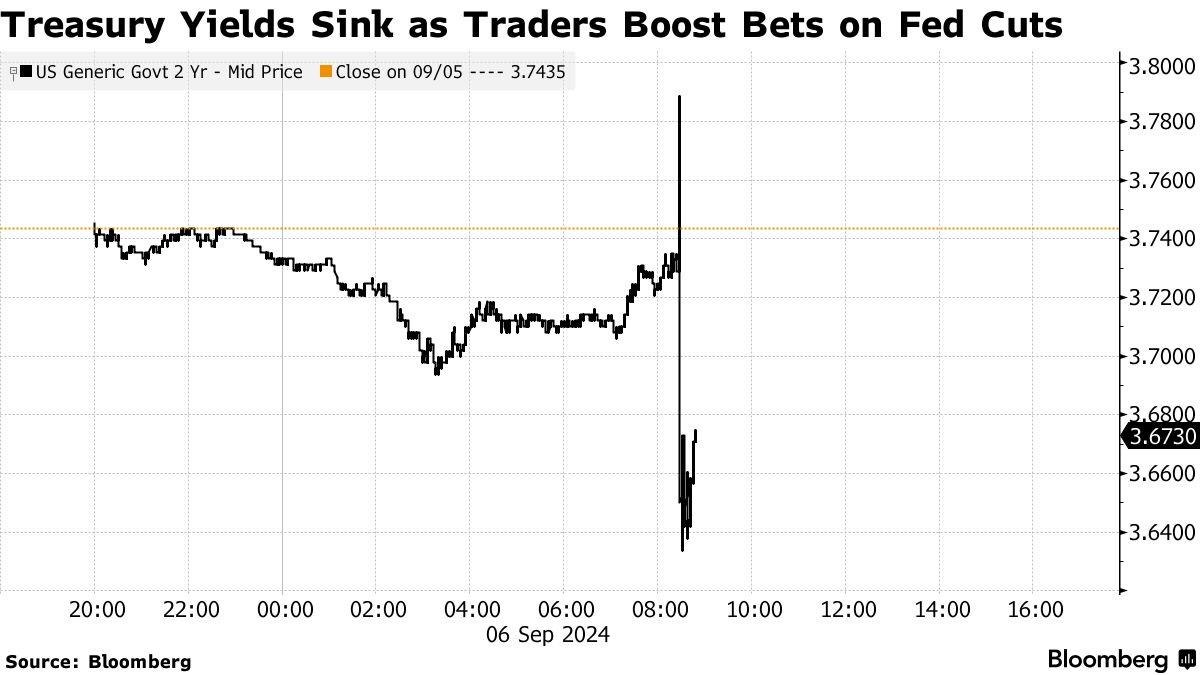Welcome to The Wolf Den! This is where I share the news, my ideas about the market, technical analysis, education and my random musings. The newsletter is released every weekday and is completely FREE. Subscribe!
Today’s Newsletter Is Made Possible By Arch Public!
Last week Arch Public clients crushed the broader markets: +10.7%. Multiple algorithms taking positive trades and zero losing positions. If you haven’t joined us, you’re missing out on significant returns and uncorrelated alpha.
Try Arch Public now! You can even demo the platform, for free, to learn more.
In This Issue:
Margin Trading
Bitcoin Thoughts And Analysis
Legacy Markets
Mark You Calanders, The Debate Is Soon!
Robinhood Settles With The DOJ
Morgan Stanley + BlackRock
Mainstream Media Thinks We Are Panicking
Bitcoin Will Hit $200,000 In 2025 | Mike Alfred
Margin Trading
Here’s the deal: trading is one thing, but margin trading is a whole different ballgame. If you’re here, you likely know the basics of trading, and you might even have some experience with margin trading. But do you truly understand how to use it the right way? I can confidently say that 90% of margin traders misuse it, leading to unnecessary risk—and often worse outcomes.
Let’s break down margin trading. It involves borrowing money to trade with more capital than you actually have. For example, if you have $1,000 and use 5x margin, you’re borrowing $4,000, giving you $5,000 to trade—five times your initial amount. You’ll pay daily interest on that borrowed money, but you keep all the profits from trading the full $5,000.
It might sound like an easy way to multiply profits, but remember, you’re still responsible for that $4,000 loan, even if your trade loses money.
The key is understanding why and how to use margin trading. Most people jump in hoping to amplify their gains, but often without proper risk management. They go all in, leveraging 5x, 10x, or even 100x, dramatically increasing their risk. At that point, you might as well be gambling at a casino.
So, what’s the right way to use margin trading? For professionals, it’s almost the opposite of what most casual traders do. They use margin not to increase risk, but to *reduce* it, while following strict risk management strategies.
You’ve probably heard the saying, “Not your keys, not your coins.” When trading, however, you have to store your funds on an exchange—especially when margin trading, which is usually done on centralized platforms. Storing $100,000 on a centralized exchange exposes you to risks like hacking, exchange failures, or even the platform disappearing altogether. This is where margin trading, when done correctly, can mitigate those risks. Instead of depositing the full $100,000, you might only deposit $20,000 and borrow the remaining $80,000. This way, you’re still trading with your usual amount but have significantly reduced your exposure to exchange risk.
Professionals also use margin trading to adhere to risk management strategies. For example, if your rule is to only risk 1% of your capital on a single trade, you could enter a $100 trade with a stop loss at $99.70, which represents a 0.3% loss. Using margin allows you to adjust your trade size so that a small loss in the market aligns with your 1% risk limit.
Another essential use of margin trading is shorting an asset. Let’s say you anticipate Bitcoin will drop, but you don’t own any. With margin, you can still profit from the decline by shorting it. Essentially, you borrow Bitcoin to sell it at a higher price, then repurchase it at a lower price. For instance, if you borrow 10 Bitcoin and sell them at $100 each, then wait for the price to drop to $50, you can buy back 20 Bitcoin for the same amount of money. After repaying the borrowed 10 Bitcoin, you’re left with 10 extra Bitcoin.
Now that you understand the basics, let’s delve into a final key point to maximize your potential. Suppose you start with 10 Bitcoin, each worth $10,000, giving you $100,000 in capital. You transfer 2 Bitcoin to the exchange and keep the remaining 8 Bitcoin in your private wallet. You then borrow 8 Bitcoin to trade, giving you a total of 10 Bitcoin to work with. After a successful trade, you end up with 12 Bitcoin. Once you repay the 8 Bitcoin you borrowed, you transfer the remaining 4 Bitcoin to your wallet, leaving you with 12 Bitcoin in total.
However, if Bitcoin’s price drops to $8,000 during this time, your total capital becomes 12 Bitcoin x $8,000 = $96,000. While you’ve increased your Bitcoin holdings, the dollar value of your investment has decreased.
Here’s how margin trading can help protect against such losses: If you’re concerned about Bitcoin’s price dropping, you can hold your capital in a stablecoin like USDT, which maintains its value. For example, if you have $100,000, you could transfer $20,000 worth of USDT to the exchange and borrow 10 Bitcoin at $10,000 each. After a successful trade, you end up with 12 Bitcoin. Even if Bitcoin’s price drops to $8,000, you repay the borrowed 10 Bitcoin, leaving you with 2 Bitcoin. Meanwhile, your $20,000 USDT on the exchange and $80,000 USDT in your wallet remain intact, giving you $100,000 in stablecoins, plus the value of your 2 Bitcoin ($16,000), for a total of $116,000—an increase of $12,000 compared to holding everything in Bitcoin.
This approach also works in the opposite direction. If you expect Bitcoin’s price to rise, you can hold Bitcoin, borrow USDT, and potentially multiply your profits.
That covers the essentials of margin trading. If it still feels overwhelming, stick with spot trading for now. Remember, margin is a tool you can use when you’re ready. Also, keep in mind that margin trading isn’t free—fees can accumulate alongside your profits and losses, so be sure to factor them in.
Wishing you all an amazing weekend! September will be over soon—the second-to-last hurdle before the election. Expect volatility, and don’t let your conviction waver based on price movements.
Before I wrap up, I want to briefly mention that all of the analysts are killing it for Wolf Pack members, who enjoyed multiple pieces of content yesterday. Also, as the name implies, I do videos on ‘The Everyday Howl’ every day to go along with the content from all the analysts I’ve hired to join me.
You won’t see this exclusive content anywhere else—join The Wolf Pack today.
Bitcoin Thoughts And Analysis
There is bullish divergence everywhere on the 12 hour chart and every other lower time frame.
That means that RSI is rising (more buying pressure) as price drops.
I see no reason to be particularly panicked at the moment, which is all I am seeing on X.
Legacy Markets
U.S. Treasury yields dropped after the release of a weaker-than-expected August jobs report, which fueled speculation that the Federal Reserve may implement a larger rate cut in September. Nonfarm payrolls increased by 142,000, falling short of estimates, while revisions to the previous two months’ data showed weaker job growth than initially reported. Despite the muted payroll gains, the unemployment rate dropped to 4.2%, the first decline in five months, driven by a reversal in temporary layoffs.
The bond market reacted sharply, with two-year Treasury yields falling seven basis points to 3.68%. Swap traders now see a 50% chance of a half-point rate cut by the Fed in September, up from earlier expectations of a smaller 25 basis-point cut. Average hourly earnings increased by 0.4%, adding to the mixed signals about the strength of the labor market.
While some market participants believe this softer jobs report supports the case for a 50 basis-point rate cut, others remain cautious, viewing the 25 basis-point cut as the more likely scenario. Chris Larkin of E*Trade from Morgan Stanley noted that the Fed is likely to remain cautious, and markets will be sensitive to any further data suggesting the economy is cooling more than anticipated. Stocks fluctuated as investors digested the implications of the report for the Fed’s upcoming decision.
Some of the main moves in markets:
Stocks
S&P 500 futures rose 0.1% as of 8:50 a.m. New York time
Nasdaq 100 futures were little changed
Futures on the Dow Jones Industrial Average were little changed
The Stoxx Europe 600 rose 0.2%
The MSCI World Index rose 0.1%
Currencies
The Bloomberg Dollar Spot Index fell 0.3%
The euro rose 0.2% to $1.1134
The British pound rose 0.4% to $1.3229
The Japanese yen rose 0.5% to 142.76 per dollar
Cryptocurrencies
Bitcoin rose 1.2% to $56,722.24
Ether rose 1.5% to $2,403.22
Bonds
The yield on 10-year Treasuries declined three basis points to 3.70%
Germany’s 10-year yield declined three basis points to 2.18%
Britain’s 10-year yield declined four basis points to 3.87%
Commodities
West Texas Intermediate crude rose 0.7% to $69.60 a barrel
Spot gold rose 0.4% to $2,527.08 an ounce
Mark You Calanders, The Debate Is Soon!
I found an article that has all the rules you need to know about the upcoming debate scheduled for next week. I copied them below:
The debate will be 90 minutes long and will have two commercial breaks.
The moderators for the debate are ABC News’ David Muir and Linsey Davis. They will also be the only people asking questions.
A virtual coin flip was conducted on September 3 to determine the podium placement and who will have the final words. Trump won the toss and chose to offer the closing statement at the debate. Meanwhile, Harris selected the right podium position on screen.
No opening or closing statements can be longer than two minutes per candidate.
The participants have to stand behind the podium, throughout the duration of the debate.
Props and handwritten notes will not be allowed on stage.
The candidates have been allotted, 2 minutes to answer questions posed to them, two minutes for rebuttal and one extra minute for any follow-ups, clarifications, or responses.
Topic points or questions will not be shared in advance with the campaign or candidates.
The participants’ microphones will remain muted if it is not their turn to speak.
Candidates will not be permitted to ask questions of each other.
Campaign staff are not allowed to interact with the candidates during the duration of the debate and even during breaks.
There will be no audience in the room.
The debate will take place on Sept. 10 at 8 p.m. Central Time
Robinhood Settles With The DOJ
On Sept. 4, Wednesday, Robinhood Crypto reached a $3.9 million settlement with the California Department of Justice over claims it violated the California Commodities Law between 2018 and 2022. The platform allegedly prevented customers from withdrawing digital assets, forcing them to sell back to Robinhood instead of transferring to external wallets. Robinhood also faced charges for misleading advertising, failing to fulfill its promise of providing the best available prices through third-party venues.
What confuses me about this action is that almost every major platform that initially got into crypto didn’t allow withdrawals. For a long time, it was the #1 complaint users had with these platforms. Did Venmo, PayPal, and Cash App face similar scrutiny from the California DOJ, or is this just about Robinhood? I’d also like to know what roadblocks prevented executives from enabling withdrawals sooner. Since the GameStop incident, Robinhood has been operating transparently, and I don’t think this story reflects negatively on the platform’s integrity.
Morgan Stanley + BlackRock
Morgan Stanley reported a 2.1% exposure to BlackRock’s spot Bitcoin ETF (IBIT) in one of its institutional funds, which is notable percentage-wise, but modest in total size. With just $10 million in assets, the IBIT holdings amount to about $221,000, while the MicroStrategy (MSTR) holdings are around $400,000. Both IBIT and MSTR rank among the fund's top-ten holdings, but the issue is the fund itself is relatively small. Still, this is just the beginning. Imagine the impact when Bitcoin makes its way into billion-dollar funds—not just a few, but nearly all of them. That’s when the real shift happens. Here’s how it will go: TradFi starts small, tests the waters, and gradually moves into larger funds with more substantial allocations.
Mainstream Media Thinks We Are Panicking
You’ve got to appreciate articles like this. Institutions aren’t panicking; this is exactly what I mean when I say that bottoming is a process. As articles like this accumulate during a price decline, the market eventually becomes attractive to long-term holders, and news begins to reflect the shift in sentiment.
That said, it has been a bad week for ETFs, “over the past week, BTC ETFs have experienced significant outflows. With 10 ETFs collectively withdrawing 10,428 BTC, valued at approximately $601 million. On Wednesday, September 4, the spot Bitcoin ETFs registered the sixth consecutive day of outflows at $37.29 million. However, this was significantly less than the $237 million in outflows on Tuesday.”
All it’s going to take is a bounce-back day, with some follow-up with strong news and everyone will be convinced the market is back.
Bitcoin Will Hit $200,000 In 2025 | Mike Alfred
Mike Alfred joins me today to provide his bullish opinion on Bitcoin. Don't miss this show! In the second part of the show, Dan from The Chart Guys will share his market analysis and some trades.
My Recommended Platforms And Tools
The Wolf Pack - A cutting-edge platform designed to transform your engagement with high-level content and industry leaders. Join The Wolf Pack now!
Phemex - Exclusive for new users, earn up to 8800 USDT. Also for a limited time, if you mint your soul pass you will pay no gas fees and enjoy VIP benefits. Use MY LINK to get the rewards!
Arch Public - It’s a hedge fund in your pocket. Built for retail traders, designed to outperform Wall Street. Try emotionless algorithmic trading at Arch Public today.
Trading Alpha - Trade With Confidence! My new go-to indicator site and trading community. Use code '10OFF' for a 10% discount.
X - I spend most of my time on X, contributing to CryptoTownHall every weekday morning, sharing random charts, and responding to as many of you as I can.
YouTube - Home of the Wolf Of All Streets Podcast and daily livestreams. Market updates, charts, and analysis! Sit down, strap in, and get ready—we’re going deep
The views and opinions expressed here are solely my own and should in no way be interpreted as financial advice. Every investment and trading move involves risk. You should conduct your own research when making a decision. I am not a financial advisor. Nothing contained in this e-mail constitutes or shall be construed as an offering of financial instruments or as investment advice or recommendations of an investment strategy or whether or not to "Buy," "Sell," or "Hold" an investment.














